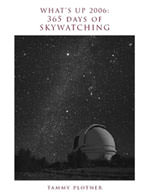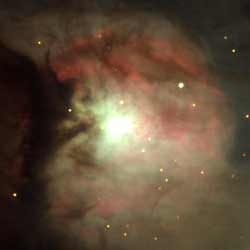
Download our free “What’s Up 2006” ebook, with entries like this for every day of the year.
|

M43: “The Fishmouth”. Image credit: N.A. Sharp/NOAO/AURA/NSF. Click to enlarge.
Monday, January 30 – The Moon is now a thin crescent at sunset but no problem for dark sky observing. Tonight let’s have a look at the “Great Nebula” in Orion and its shy neighbor – M43.
M43 has its own special beauty. First discovered by Jean-Jacques D’Ortous de Mairan in the early eighteenth century, M43 is actually a continuation of M42 blocked by a dark slash of nebulosity called the “Fishmouth.” The star illuminating M43 is variable NU Orionus – which ranges about one magnitude in brilliance. Like its overpowering neighbor, M43 is a stellar nursery with the beginnings of its own cluster held close to its heart.
Tuesday, January 31 – Tonight in 1862, Alvan Graham Clark, Jr. made an unusual discovery. While watching Sirius, Clark uncovered the intense star’s faint companion while testing an 18″ refractor for Dearborn Observatory. The scope itself was built by Clark, his father and his brother. Imagine his excitement when it turned up the white dwarf – Sirius B! Based on the strange way Sirius A wobbles in the sky, Friedrich Bessel proposed its B’s existence back in 1844, but this is the first time it was confirmed visually.
Sirius B is nicknamed “the Pup,” and tonight we’ll have a serious look at Sirius, and see what it takes to uncover its little companion. Sirius is the brightest star that normally graces the night sky. At magnitude -1.6, it produces so much light that the atmosphere won’t stand still for it – sometimes even flashing in vibrant colors! This means that poor “Pup” hardly stands a chance of being seen. At magnitude 8.5 it could easily be caught in binoculars if it were on its own. So how do you find it? First, you’ll need a mid-to-large telescope with a high power eyepiece. Second, add a stable evening – not night – sky around the time Sirius is as high up as possible. Third, you’ll have to train your eye to perceive something that will cause you to say “I could hardly believe my eyes!” – because it’s that faint. Seeing the Pup is a Sirius matter, but practice will help you walk “the Pup” out of the evening sky!
If you had problems finding it, don’t worry… Others have problems, too. On this night in 1948, the first test photos using the Hale 5-meter (200-inch) telescope at Mt. Palomar were underway. Believe it or not, problems with the configuration and mounting of the mirror meant that it was almost 2 years later before the first observing run was made by a scheduled astronomer!
Wednesday, February 1 – The Moon has returned. Could you spot its slender crescent last night? If not, then try again tonight as we aim binoculars and telescopes toward the lunar surface.
Look almost centrally on the terminator for the very conspicuous crater Langrenus. Depending on your viewing location and time, it may be divided by the terminator, but will be quite recognizable. Spanning 85 miles in diameter, the steep, rugged walls rise almost 16,200 feet above the crater’s floor and you’ll see their bright outline on the western edge. Can you spot its central peak? It’s small for a crater this size and will present a challenge for binoculars.
While we’re out, let’s revisit the Crab Nebula in Taurus – there’s so much to learn and see about this very special nebula. The label “planetary” is a definite misnomer. Unlike most with this designation, M1 hardly looks like a globe and varies in other significant ways. Most planetaries have central stars that spew out atmospheric gases on a regular basis – but not this one. M1 did it all at once and we know exactly when it happened.
As one of only about 20 supernovae seen before the invention of the telescope, 11th century Chinese astronomers thought it four times brighter than Venus. Seen in broad daylight, the supernova remained visible for more than three weeks and continued to be seen in the night sky for almost two years. The position recorded for that July 4th, 1054 AD discovery now corresponds with that of the Crab Nebula.
Thursday, February 2 – There’s no missing the Moon tonight, so let’s go explore. Notice how crater Langrenus has changed in just 24 hours! Our study will be a trio of craters that look very much like a?? paw print on the surface. Just northeast of Langrenus’ border, look for the collection of Naonobu (north), Atwood (south) and Bilharz (west). Power up and try an even more challenging crater almost on the edge of Langrenus’ northern rim. This small pock-mark is known as Acosta.
When the Moon has begun to set, let’s have a look at a pair of neighboring open clusters in Gemini – M35 and NGC 2158. While both can be seen in the same low-power field, only M35 is visible in binoculars – as a round nebulosity as large as the Moon’s disc and peppered with faint stars. This is precisely how NGC 2158 looks in a mid-sized telescope. Like many of the brighter Messier studies, M35 was observed by others before Charles began looking for comets and kept running into deep sky objects. Keep in mind as you view these two galactic clusters that faint NGC 2158 is 16,000 light years away. That’s five times more distant than M35!
Tomorrow morning, observers in far western North America and Hawaii, will have the opportunity to see the Moon occult 4.5 magnitude Epsilon Piscium. Check the IOTA webpage to determine times and locales for Epsilon’s disappearance on the Moon’s shadowed side and reappearance on its bright limb. Keep the site bookmarked and use it as a reference throughout the observing year for other similar events.
Friday, February 3 – On this day in 1966, the first soft landing on the Moon occurred as Soviet probe Luna 9 touched down and sent back the very first pictures from the surface. Although Luna 9’s landing area in the Oceanus Procellarum is not visible tonight, we’ll discover two giants – Atlas and Hercules.
Located in the northeastern quarter of the lunar surface, this pair of craters is very prominent tonight in either binoculars or telescopes. The smaller, western crater is Hercules and the larger one is Atlas. When Hercules is near the terminator its western bright wall is in strong contrast to an interior so deep that it remains in shadow. Spanning 45 miles in diameter and plunging down 12,500 feet, Crater Hercules also contains an interior crater revealed as the Sun rises over it in the next 24 hours. Far more detail tonight is shown in much older crater Atlas. Spanning 54 miles in diameter and more shallow at 10,000 feet, Atlas contains a small interior peak. Power up and see if you can spot a Y-shaped crack along Atlas’ floor known as the Rimae Atlas.
If you’re in the mood to stay out a bit later, let the Moon set and have a look at the Eskimo Nebula (NGC 2392) in Gemini. Discovered by William Herschel in 1787, the 5000 light year distant NGC 2392 gives the appearance of a parka hooded face in large telescopes. In the center is a single 10th magnitude star – the source of both the planetary’s nebulosity and its light. Smaller scopes easily show both the central star and bright mantle of gas with a hint of “fuzzy” around the edge. Although the Eskimo is looking at us – it’s moving away at 75 km per second.
To find the “Eskimo,” start at Delta Geminorum and look about a finger width east/southeast for dim star 63. NGC 2392 is a little more than half a degree southeast, very near the ecliptic. Power up to get the best possible view of this 10th magnitude beauty. For those with a nebula filter, try it. This particular nebula will look much like a glowing green telrad.
Saturday, February 4 – Today is the birthday of Clyde Tombaugh. Born in 1906, Tombaugh discovered Pluto 24 years and two weeks after his birth. It will be a few months before we have an opportunity to see Pluto, but it’s grand to think that hard work and perseverance can accomplish some extraordinary things.
Let’s have a look at the lunar surface tonight and return to crater Posidonius. Located on the northeast shore of Mare Serenitatis and near the terminator, this large, ancient walled plain is an example of a Class V crater. Posidonius appears to be very flat – and with good reason. While its dimensions are roughly 52 by 61 miles, the crater itself is only 8,500 feet deep. The bright ring of the structure remains conspicuous to binoculars throughout all lunar phases, but a telescope is needed to appreciate the many fine features found on Posidonius’ floor. Power up to observed the stepped, stadium-like wall structure and numerous resolvable mountain peaks joining its small, central interior crater.
Before the Moon dominates the evening skies, let’s turn our attention towards the faintest of the three Messier open clusters in Auriga – M38. You’ll find it located almost precisely between Iota and Theta Aurigae. This 6.4 magnitude galactic cluster resolves into more than two dozen stars in small scopes, with its brighter members giving the appearance of an “X” in space. Like M35, M38 shares the field with a much fainter and denser companion. Look another half degree see to find the 8th magnitude cluster NGC 1907.
Sunday, February 5 – On this day in 1963, Maarten Schmidt measured the first redshift of a distant quasar and revealed just how luminous these stellar appearing objects are. And in 1974 the first close-up photograph of Venus was made by Mariner10.
The most outstanding feature tonight on the Moon will be a southern crater near the terminator – Maurolycus. Depending on your viewing time, the terminator may be running through it. These shadows will multiply its contrast many times over and display its vivid formations. As an Astronomy League challenge, Maurolycus will definitely catch your eye with its black interior and western crest stretched over the terminator’s darkness. Too many southern craters to be sure? Don’t worry. Maurolycus dominates them all tonight. Look for its double southern wall and multiple crater strikes along its edges.
Now let’s journey towards Auriga and drop a fist’s width south of Alpha (Capella). Congratulations on finding M38 under the moonlight! We’ll look again at this superb open cluster under darker skies.
May all your journeys be at light speed… ~Tammy Plotner. Additional writing by Jeff Barbour @ astro.geekjoy.com
